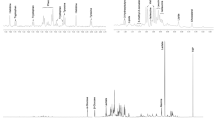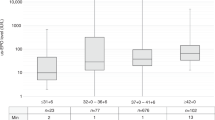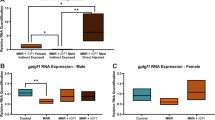Abstract
Various hypothalamic functions such as feeding behavior, energy expenditure, body weight gain, level of anxiety, and sexual maturation are mediated by a balance between the concentrations of neuropeptide Y (NPY) and corticotropin-releasing factor (CRF). To test the hypothesis that maternal uteroplacental insufficiency alters the offspring's brain NPY and/or CRF levels, we examined the effect of maternal uterine artery ligation with intrauterine growth restriction (IUGR) (p < 0.05) upon fetal(20 d) and postnatal (4, 14, and 21 d) brain NPY and CRF synthesis, concentrations, and regional distribution. An age-related increase in NPY(0.8 kb) and CRF (1.4 kb) mRNA levels with peak amounts at the 14-d postnatal age (p < 0.05) was observed. IUGR was associated with a 75% increase in fetal brain NPY mRNA levels (p < 0.05) with no change in NPY peptide, CRF mRNA and peptide amounts. Although the increase in NPY mRNA levels persisted postnatally (p < 0.05) at d 4 and 21, CRF mRNA amounts were 2.5-fold higher only in the 4-d IUGR (p < 0.05). Paralleling the mRNA changes, an age-related increase in RIA of NPY and CRF peptide concentrations was noted (p < 0.05). IUGR caused postnatal brain NPY and CRF peptide changes similar to corresponding mRNA levels (p < 0.05), despite normal postnatal circulating glucose, insulin, corticosterone, and leptin concentrations. The age-specific intergroup differences in the NPY and CRF peptide immunoreactivity appeared predominantly in the hypothalamic region. We conclude that maternal uteroplacental insufficiency causing IUGR leads to a pretranslational imbalance in the immediate (4 d) postnatal brain NPY and CRF peptide concentrations, thereby altering the developmental pattern. This alteration in NPY and CRF peptide concentrations, despite normalization of the metabolic milieu was associated with a persistent diminution in body weight. The IUGR-associated pretranslational increase in NPY and not CRF peptide levels at d 21, may herald changes in feeding behavior during the postsuckling phase.
Similar content being viewed by others
Log in or create a free account to read this content
Gain free access to this article, as well as selected content from this journal and more on nature.com
or
Abbreviations
- IUGR:
-
intrauterine growth restriction
- SHAM:
-
sham-operated controls
- NPY:
-
neuropeptide Y
- CRF:
-
corticotropin-releasing factor
References
Danger JM, Tonon MC, Jenks BG, Saint-Pierre S, Martel JC, Fasalo A 1990 Neuropeptide Y: localization in the central nervous system and neuroendocrine functions. Fundam Clin Pharamcol 4: 307–340
Erickson JC, Clegg KE, Palmiter RD 1996 Sensitivity to leptin and susceptibility to seizures of mice lacking neuropeptide Y. Nature 381: 415–421
Wahlestedt C, Pich EM, Koob GF, Yee F, Heilig M 1993 Modulation of anxiety and neuropeptide Y-Y1 receptors by antisense oligodeoxynucleotides. Science 259: 528–531
Heilig M, McLeod S, Menzaghi F, Heinrichs SC, Brot M, Koob GF, Britton KT 1993 Anxiolytic-like action of neuropeptide Y: mediation by Y1 receptors in amygdala, and dissociation from food intake effects. Neuropsychopharmacology 8: 357–363
Clark JT, Kalra PS, Kalra SP 1985 NPY stimulates feeding but inhibits sexual behavior in rats. Endocrinology 115: 427–429
Pierroz DD, Catzefles C, Aebi AC, Rivier JE, Aubert ML 1996 Chronic administration of neuropeptide Y into the lateral ventricles inhibits both the pituitary-testicular axis and growth hormone and insulin-like growth factor I secretion in intact adult male rats. Endocrinology 137: 3–12
Stanley BG, Kyrkouli S, Lampert S, Liebowitz S 1986 Neuropeptide Y chronically injected into the hypothalamus: a powerful neurochemical inducer of hyperphagia and obesity. Peptides 7: 1189–1192
Zukowska-Grojec Z, Wahlestedt C 1993 Origin and actions of neuropeptide Y in the cardiovascular system. In: Colmers WF, Wahlestedt C(eds) The Biology of Neuropeptide Y and Related Peptides. Humana Press, Totowa, NJ, pp 315–388
Zarjevski N, Cusin I, Vettor R, Rohner-Jeanrenaud F, Jeanrenaud B 1993 Chronic intracerebroventricular neuropeptide Y administration to normal rats mimics hormonal and metabolic changes of obesity. Endocrinology 133: 1753–1758
Dallman MF, Akana SF, Strack AM, Hanson ES, Sebastian RJ 1995 The neural network that regulates energy balance is responsive to glucocorticoids and insulin and also regulates HPA axis responsivity at a site proximal to CRF neurons. Ann NY Acad Sci 771: 730–742
Hauger RL, Millan MA, Catt KJ, Arguilera G 1987 Differential regulation of brain and pituitary corticotropin-releasing factor receptors by corticosterone. Endocrinology 120: 1527–1533
Richard D 1993 Involvement of corticotropin-releasing factor in the control of food intake and energy expenditure. Ann NY Acad Sci 697: 155–172
Heinrichs SC, Cole BJ, Pich EM, Menzaghi F, Koob GF, Hauger RL 1992 Endogenous corticotropin-releasing factor modulates feeding induced by neuropeptide Y or a tail-pinch stressor. Peptides 13: 879–884
Sipols AJ, Baskin DG, Schwartz MW 1995 Effect of intracerebroventricular insulin infusion on diabetic hyperphagia and hypothalamic neuropeptide gene expression. Diabetes 44: 147–151
McKibben PE, McCarthy HD, Shaw P, Williams G 1992 Insulin deficiency is a specific stimulus to hypothalamic neuropeptide Y: a comparison to the effects of insulin replacement and food restriction in streptozotocin-diabetic rats. Peptides 13: 721–727
Allen JM, McGregor GP, Woodhams PL, Polak JM, Bloom SR 1984 Ontogeny of a novel peptide, neuropeptide Y (NPY) in rat brain. Brain Res 303: 197–200
Woodhams PL, Allen YS, McGovern J, Allen JM, Bloom SR, Balazs R, Polak JM 1985 Immunohistochemical analysis of the early ontogeny of the neuropeptide Y system in rat brain. Neuroscience 15: 173–202
Frederich RC, Lollmann B, Hamann A, Napolitano-Rosen A, Kahn BB 1995 Expression of ob mRNA and its encoded protein in rodents. J Clin Invest 96: 1658–1663
Wang Q, Bing C, Al-Barazanji K, Mossakowaska DE, Wang XO M, McBay DL, Neville WA, Taddayon M, Pickavance L, Dryden S, Thomas MEA, McHale MT, Gloyer IS, Wilson S, Buckingham R, Arch JRS, Trayhurn P, Williams G 1997 Interactions between leptin and hypothalamic neuropeptide Y neurons in the control of food intake and energy homeostasis in the rat. Diabetes 46: 335–341
Singh BS, Westfall TC, Devaskar SU 1997 Maternal diabetes induced hyperglycemia and acute intracerebroventricular hyperinsulinism suppress fetal brain neuropeptide Y concentrations. Endocrinology 138: 963–969
Ogata ES, Bussey ME, Finley S 1985 Altered gas exchange, limited glucose and branched chain amino acids and hypoinsulinemism retard fetal growth in the rat. Metabolism 35: 970–977
Ogata ES, Swanson SL, Collin JW, Finley SL 1990 Intrauterine growth retardation: altered hepatic energy and redox states in the fetal rat. Pediatr Res 27: 56–63
Ogata ES, Bussey ME, LaBarbera A, Finley S 1985 Altered growth, hypoglycemia, hypoalaninemia, and ketonemia in the young rat: postnatal consequences of intrauterine growth retardation. Pediatr Res 24: 384–390
Lane RH, Flozak AS, Ogata ES, Bell GI, Simmons RA 1996 Altered hepatic gene expression of enzymes involved in energy metabolism in the growth retarded fetal rat. Pediatr Res 39: 390–394
Unterman TG, Simmons RA, Glick RP, Ogata ES 1993 Circulating levels of insulin, insulin-like growth factor-I (IGF-I), IGF-II, and IGF-binding proteins in the small for gestation age fetal rat. Endocrinology 132: 327–336
Sadiq HF, deMello DE, Devaskar SU 1998 Effect of uteroplacental insufficiency upon fetal and postnatal hepatic glucose transporter proteins. Pediatr Res 43: 91–100
Simmons RA, Gounis AS, Bangalore SA, Ogata ES 1992 Intrauterine growth retardation: fetal glucose transport is diminished in lung but spared in brain. Pediatr Res 31: 59–63
Devaskar S, Ganguli S, Devaskar U, Sperling MA 1982 Glucocorticoids and hypothyroidism modulate development of fetal lung insulin receptors. Am J Physiol 242: E385–E391
Maffei M, Halaas J, Ravissin E, Pratley RE, Lee CH, Zhang Y, Fei H, Kim S, Lallone R, Ranganathan S, Kern PA, Friedman JM 1995 Leptin levels in human and rodent: measurement of plasma leptin and ob RNA in obese and weight-reduced subjects. Nat Med 1: 1155–1161
Larhammer D, Ericsson A, Persson H 1987 Structure and expression of the rat neuropeptide Y gene. Proc Natl Acad Sci USA 84: 2068–2072
Jingami H, Mizuno N, Takahashi H, Shibihara S, Furutani Y, Imura H, Numa S 1985 Cloning and sequence analysis of cDNA for rat corticotropin releasing factor precursor. FEBS Lett 191: 63–66
Chan YL, Gutell R, Noller HF, Wool IG 1984 The nucleotide sequence of a rat 18S ribosomal ribonucleic acid gene and a proposal for the secondary structure of 18S ribosomal ribonucleic acid. J Biol Chem 259: 224–230
Devaskar SU, Ollesch C, Rajakumar RA, Rajakumar PA 1997 Developmental changes in ob gene expression and circulating leptin peptide concentrations. Biochem Biophys Res Commun 238: 44–47
Ciarleglio AE, Beinfeld MC, Westfall TC 1993 Pharmacological characterization of the release of neuropeptide Y-like immunoreactivity from the rat hypothalamus. Neuropharmacology 32: 819–825
Devaskar SU, Zahm DS, Holtzclaw L, Chundu K, Wadzinski BE 1991 Developmental regulation of the distribution of rat brain insulin-insensitive (Glut 1) glucose transporter. Endocrinology 129: 1530–1540
Zar JH 1984 Biostatistical Analysis. Prentice Hall, Englewood Cliffs, NJ, pp 51–52
Grino M, Paulmyer-Lacroix O, Faudon M, Renard M, Anglade G 1994 Blockade of α2-adrenoceptors stimulates basal and stress-induced adrenocorticotropin secretion in the developing rat through a central mechanism independent from corticotropin-releasing factor and arginine vasopressin. Endocrinology 135: 2549–2557
Pesonen U, Hupponen R, Rouru J, Koulu M 1992 Hypothalamic neuropeptide expression after food restriction in Zucker rats: evidence of persistent neuropeptide Y gene activation. Mol Brain Res 16: 255–260
Thompson CH, Sanderson AL, Sandeman D, Stein C, Borthwick A, Radda GK, Phillips DI 1997 Fetal growth and insulin resistance in adult life: role of skeletal muscle. Clin Sci 92: 291–296
Zarjevski N, Cusin I, Vettor R, Rohner-Jeanrenaud F, Jeanrenaud B 1994 Intracerebroventricular administration of neuropeptide Y to normal rats has divergent effects on glucose utilization by adipose tissue and skeletal muscle. Diabetes 43: 764–769
Acknowledgements
The authors thank Thomas C. Westfall (St. Louis University, St. Louis, MO) for the rabbit anti-rat NPY antibody which was used in the RIA, Carol Minth (University of Michigan, Ann Arbor, MI) for the rat preproNPY cDNA, Wylie Vale (Salk Institute, La Jolla, CA) for the rat CRF cDNA, and Yuen-Ling Chan (University of Chicago, Chicago, IL) for the 18 S rRNA and cDNA which were used in the Northern blot analyses.
Author information
Authors and Affiliations
Additional information
Supported by National Institutes of Health Grants HD 25024 (S.U.D.), HD 33997 (S.U.D.), and KO8 DK02269 (R.A.S.) and the Twenty-five club neonatal research funds, Pittsburgh, PA (S.U.D.). P.A.R. was supported by an Irene McLenahan Fellowship Award from the Magee-Womens Research Institute, Pittsburg, PA.
Presented in an abstract form at the Society for Pediatric Research Meetings 1996 held in Washington, DC.
Rights and permissions
About this article
Cite this article
Rajakumar, P., He, J., Simmons, R. et al. Effect of Uteroplacental Insufficiency upon Brain Neuropeptide Y and Corticotropin-Releasing Factor Gene Expression and Concentrations. Pediatr Res 44, 168–174 (1998). https://doi.org/10.1203/00006450-199808000-00005
Received:
Accepted:
Issue date:
DOI: https://doi.org/10.1203/00006450-199808000-00005
This article is cited by
-
Fetal origins of obesity: a novel pathway of regulating appetite neurons in the hypothalamus of growth-restricted rat offspring
Archives of Gynecology and Obstetrics (2023)
-
Mechanisms affecting neuroendocrine and epigenetic regulation of body weight and onset of puberty: Potential implications in the child born small for gestational age (SGA)
Reviews in Endocrine and Metabolic Disorders (2012)



